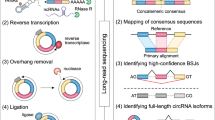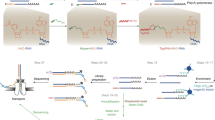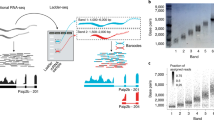Abstract
Large-scale sequencing projects have revealed an unexpected complexity in the origins, structures and functions of mammalian transcripts. Many loci are known to produce overlapping coding and noncoding RNAs with capped 5′ ends that vary in size. Methods to identify the 5′ ends of transcripts will facilitate the discovery of new promoters and 5′ ends derived from secondary capping events. Such methods often require high input amounts of RNA not obtainable from highly refined samples such as tissue microdissections and subcellular fractions. Therefore, we developed nano–cap analysis of gene expression (nanoCAGE), a method that captures the 5′ ends of transcripts from as little as 10 ng of total RNA, and CAGEscan, a mate-pair adaptation of nanoCAGE that captures the transcript 5′ ends linked to a downstream region. Both of these methods allow further annotation-agnostic studies of the complex human transcriptome.
This is a preview of subscription content, access via your institution
Access options
Subscribe to this journal
Receive 12 print issues and online access
$259.00 per year
only $21.58 per issue
Buy this article
- Purchase on Springer Link
- Instant access to full article PDF
Prices may be subject to local taxes which are calculated during checkout





Similar content being viewed by others
Change history
06 October 2010
In the version of this article initially published, the concentration of the PCR primers for CAGEscan cDNA amplification and CAGEscan cDNA sequencing were erroneously given as millimolar instead of nanomolar. The error has been corrected in the HTML and PDF versions of the article.
References
Shiraki, T. et al. Cap analysis gene expression for high-throughput analysis of transcriptional starting point and identification of promoter usage. Proc. Natl. Acad. Sci. USA 100, 15776–15781 (2003).
Kodzius, R. et al. CAGE: cap analysis of gene expression. Nat. Methods 3, 211–222 (2006).
Carninci, P. Cap-Analysis Gene Expression (CAGE): Genome-Scale Promoter Identification and Association with Expression Profile and Regulatory Networks (Pan Stanford Publishing, Singapore, 2009).
Carninci, P. et al. Genome-wide analysis of mammalian promoter architecture and evolution. Nat. Genet. 38, 626–635 (2006).
Suzuki, H. et al. The transcriptional network that controls growth arrest and differentiation in a human myeloid leukemia cell line. Nat. Genet. 41, 553–562 (2009).
Affymetrix/Cold Spring Harbor Laboratory ENCODE Transcriptome Project et al. Post-transcriptional processing generates a diversity of 5′-modified long and short RNAs. Nature 457, 1028–1032 (2009).
Kapranov, P. et al. RNA maps reveal new RNA classes and a possible function for pervasive transcription. Science 316, 1484–1488 (2007).
Fullwood, M.J., Wei, C., Liu, E.T. & Ruan, Y. Next-generation DNA sequencing of paired-end tags (PET) for transcriptome and genome analyses. Genome Res. 19, 521–532 (2009).
Valen, E. et al. Genome-wide detection and analysis of hippocampus core promoters using DeepCAGE. Genome Res. 19, 255–265 (2009).
Zhu, Y.Y., Machleder, E.M., Chenchik, A., Li, R. & Siebert, P.D. Reverse transcriptase template switching: a SMART approach for full-length cDNA library construction. Biotechniques 30, 892–897 (2001).
Hirzmann, J., Luo, D., Hahnen, J. & Hobom, G. Determination of messenger RNA 5′-ends by reverse transcription of the cap structure. Nucleic Acids Res. 21, 3597–3598 (1993).
Ohtake, H., Ohtoko, K., Ishimaru, Y. & Kato, S. Determination of the capped site sequence of mRNA based on the detection of cap-dependent nucleotide addition using an anchor ligation method. DNA Res. 11, 305–309 (2004).
Cheng, J. et al. Transcriptional maps of 10 human chromosomes at 5-nucleotide resolution. Science 308, 1149–1154 (2005).
Meisel, A., Bickle, T.A., Krüger, D.H. & Schroeder, C. Type III restriction enzymes need two inversely oriented recognition sites for DNA cleavage. Nature 355, 467–469 (1992).
Maeda, N. et al. Development of a DNA barcode tagging method for monitoring dynamic changes in gene expression by using an ultra high-throughput sequencer. Biotechniques 45, 95–97 (2008).
Bentley, D.R. et al. Accurate whole human genome sequencing using reversible terminator chemistry. Nature 456, 53–59 (2008).
Forrest, A.R.R. & Carninci, P. Whole genome transcriptome analysis. RNA Biol. 6, 107–112 (2009).
International Human Genome Sequencing Consortium. Finishing the euchromatic sequence of the human genome. Nature 431, 931–945 (2004).
Cloonan, N. et al. Stem cell transcriptome profiling via massive-scale mRNA sequencing. Nat. Methods 5, 613–619 (2008).
Ozsolak, F. et al. Digital transcriptome profiling from attomole-level RNA samples. Genome Res. 20, 519–525 (2010).
Pruitt, K.D., Tatusova, T. & Maglott, D.R. NCBI reference sequences (RefSeq): a curated non-redundant sequence database of genomes, transcripts and proteins. Nucleic Acids Res. 35, D61–D65 (2007).
Olivarius, S., Plessy, C. & Carninci, P. High-throughput verification of transcriptional starting sites by Deep-RACE. Biotechniques 46, 130–132 (2009).
Fromont-Racine, M., Bertrand, E., Pictet, R. & Grange, T. A highly sensitive method for mapping the 5′ termini of mRNAs. Nucleic Acids Res. 21, 1683–1684 (1993).
Faulkner, G.J. et al. The regulated retrotransposon transcriptome of mammalian cell. Nat. Genet. 41, 563–571 (2009).
Carninci, P. Molecular biology: The long and short of RNAs. Nature 457, 974–975 (2009).
Gingeras, T.R. Implications of chimaeric non-co-linear transcripts. Nature 461, 206–211 (2009).
Stangegaard, M., Dufva, I.H. & Dufva, M. Reverse transcription using random pentadecamer primers increases yield and quality of resulting cDNA. Biotechniques 40, 649–657 (2006).
Spiess, A. & Ivell, R. A highly efficient method for long-chain cDNA synthesis using trehalose and betaine. Anal. Biochem. 301, 168–174 (2002).
Salimullah, M. et al. Tunable fractionation of nucleic acids. Biotechniques 47, 1041–1043 (2009).
Bhorjee, J.S. & Pederson, T. Chromatin: its isolation from cultured mammalian cells with particular reference to contamination by nuclear ribnucleoprotein particles. Biochemistry 12, 2766–2773 (1973).
Faulkner, G.J. et al. A rescue strategy for multimapping short sequence tags refines surveys of transcriptional activity by CAGE. Genomics 91, 281–288 (2008).
Hashimoto, T. et al. Probabilistic resolution of multi-mapping reads in massively parallel sequencing data using MuMRescueLite. Bioinformatics 25, 2613–2614 (2009).
Li, H. & Durbin, R. Fast and accurate short read alignment with Burrows-Wheeler transform. Bioinformatics 25, 1754–1760 (2009).
Trapnell, C., Pachter, L. & Salzberg, S.L. TopHat: discovering splice junctions with RNA-Seq. Bioinformatics 25, 1105–1111 (2009).
Severin, J. et al. FANTOM4 EdgeExpressDB: an integrated database of promoters, genes, microRNAs, expression dynamics and regulatory interactions. Genome Biol. 10, R39 (2009).
Jurka, J. et al. Repbase update, a database of eukaryotic repetitive elements. Cytogenet. Genome Res. 110, 462–467 (2005).
Acknowledgements
This work was funded by a grant of the 6th Framework of the European Union commission to the Neuro Functional Genomics consortium, by a grant of the 7th Framework to P.C. and S.G. (Dopaminet), a Grant-in-Aids for Scientific Research (A) 20241047 for P.C. and a Research Grant for RIKEN Omics Science Center from the Japanese Ministry of Education, Culture, Sports, Science and Technology to Y.H. This project was also partially supported by the U.S. National Human Genome Research Institute grant U54 HG004557. C.P. was supported by the Japanese Society for the Promotion of Science long-term fellowship P05880. S.G. was funded by a career developmental award from The Giovanni Armenise-Harvard Foundation. We thank A. Forrest for critical discussions, M. Josserand for experimental assistance and RIKEN Genome Network Analysis Service for data production.
Author information
Authors and Affiliations
Contributions
C.P., R.S. and P.C. conceived the nanoCAGE technology. C.P. and P.C. conceived the CAGEscan technology. C.P., H.T., R.S., M.S. and S.O. designed and performed the experiments. C.P., N.B., H.T., T.L. and M.V. analyzed data and interpreted results. C.P., N.B., S.G. and P.C. supervised the study. D.L., N.H., V.O., I.B., H.G., J.D., P.K., H.W., C.A.D. and T.R.G. provided material. J.S. provided software. J.K., Y.H., S.G. and P.C. provided salary support. P.C., N.B., H.T. and M.V. drafted the text and figures. C.P., N.B., T.L., C.O.D. and P.C. edited the text and figures. General correspondence should be addressed to S.G. or P.C.; correspondence about experiments, to C.P.; and correspondence about bioinformatics, to N.B.
Corresponding authors
Ethics declarations
Competing interests
C.P., P.C. and R.S. are inventors of the Japanese patent application held by RIKEN on the moderately suppressive PCR step of the nanoCAGE protocol. P.K. is currently an employee of Helicos BioSciences.
Supplementary information
Supplementary Text and Figures
Supplementary Figures 1–7 and Supplementary Tables 1–8 (PDF 2743 kb)
Rights and permissions
About this article
Cite this article
Plessy, C., Bertin, N., Takahashi, H. et al. Linking promoters to functional transcripts in small samples with nanoCAGE and CAGEscan. Nat Methods 7, 528–534 (2010). https://doi.org/10.1038/nmeth.1470
Received:
Accepted:
Published:
Issue Date:
DOI: https://doi.org/10.1038/nmeth.1470
This article is cited by
-
ZBTB12 is a molecular barrier to dedifferentiation in human pluripotent stem cells
Nature Communications (2023)
-
Dynamic regulation of N6,2′-O-dimethyladenosine (m6Am) in obesity
Nature Communications (2021)
-
Use of Cap Analysis Gene Expression to detect human papillomavirus promoter activity patterns at different disease stages
Scientific Reports (2020)
-
MAPCap allows high-resolution detection and differential expression analysis of transcription start sites
Nature Communications (2019)
-
Alternative polyadenylation coordinates embryonic development, sexual dimorphism and longitudinal growth in Xenopus tropicalis
Cellular and Molecular Life Sciences (2019)



